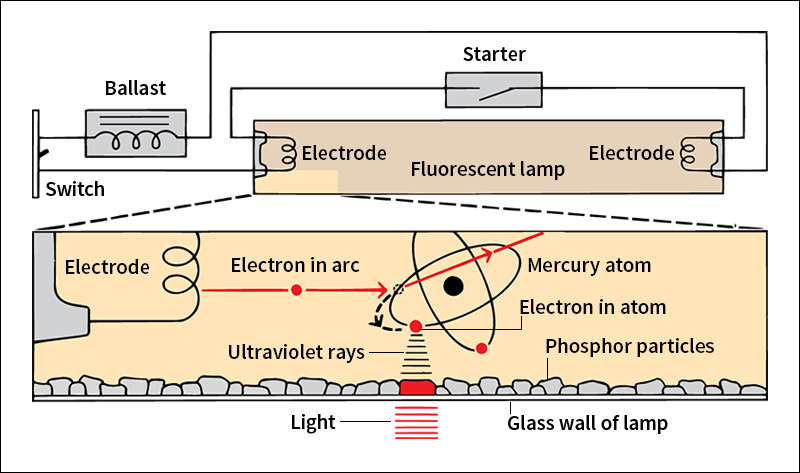Fluorescent, << `floo` REHS uhnt, >> lamp is a device that produces light by passing electric current through a gas enclosed in a tube instead of through a filament. A fluorescent lamp uses less electric power than does an incandescent lamp to produce the same amount of light. It also produces only a fifth as much heat. Fluorescent lamps last much longer than incandescent lamps and can be coiled into light-bulb shapes, called compact fluorescent lamps or lights (CFL’s). The first commercial fluorescent lamp was introduced in 1938 by the General Electric Company.

A fluorescent lamp consists of a glass tube containing, under pressure, a small amount of mercury vapor and an inert (chemically inactive) gas, typically argon. The tubes are made in a variety of shapes, including circular, straight, spiral, and U-shaped. Electric current flowing through the tube causes the mercury vapor to give off invisible ultraviolet light. The inside of the tube is coated with chemicals called phosphors that give off visible light when struck by ultraviolet rays. The color of the light depends on the phosphors. Because fluorescent lamps contain mercury, an environmentally harmful metal, they must be disposed of carefully.
There are three main kinds of fluorescent lamp circuits: (1) preheat, (2) rapid-start, and (3) instant-start. Fixtures using a preheat circuit cost the least but tend to flicker on starting and have the shortest lamp life. Lamps last longest in rapid-start fixtures, and so these fixtures are the cheapest to operate and maintain. Instant-start fixtures start more quickly but tend to have a shorter lamp life.
A fluorescent circuit includes a device called a ballast. The ballast provides voltage to start the lamp and also regulates the flow of electric current in the lamp circuit. There are two main types of ballasts: (1) magnetic and (2) electronic. In a magnetic ballast, a coil of wire acts as an inductor, opposing any increase or decrease in the flow of current (see Inductance). Electronic ballasts regulate current flow using components made from solid semiconductor materials. Such materials conduct current better than insulators but not as well as conductors. Electronic ballasts are more expensive than magnetic ones, but they are also more efficient.
At each end of the lamp is an electrode, a coil of tungsten wire coated with substances called lanthanide oxides. When a preheat or rapid-start lamp is turned on, electric current flows through the tungsten wire. The wire becomes heated, and the earth oxides give off electrons. Some electrons strike the argon atoms and ionize them—that is, give the atoms a positive or negative electric charge. When ionized, the argon can conduct electric current. Current flows through the gas from electrode to electrode, forming an arc (stream of electrons). Instant-start lamps start at such high voltage that the arc forms immediately. When an electron in the arc strikes a mercury atom, it raises the energy level of an electron in the atom. As this electron returns to its normal state, it emits ultraviolet energy.
See also Electric light; Fluorescence; Light bulb; Lighting.
